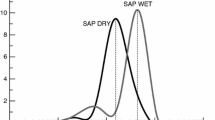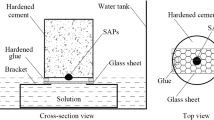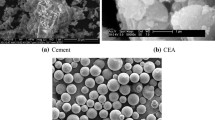Abstract
Internal curing with superabsorbent polymers (SAP) is a method for promoting hydration of cement and limiting self-desiccation, shrinkage and cracking in high-performance, and ultra high-performance concrete with low water-to-binder ratio. SAP are introduced in the dry state during mixing and form water-filled inclusions by absorbing pore solution. The absorbed solution is later released to the cement paste during hydration of the cement. In this paper, cement pastes with low water-to-binder ratios incorporating superplasticizer and different dosages of SAP and corresponding additional water were prepared. Reference cement pastes without SAP but with the same amount of water and superplasticizer were also mixed. Isothermal calorimetry was used to measure hydration heat flow. Water entrainment by means of SAP increased the degree of hydration at later hydration times in a manner similar to increasing the water-to-binder ratio. Addition of SAP also delayed the main calorimetric hydration peak compared to the reference pastes, however, in a less prominent manner than the increase in water-to-cement ratio.



Similar content being viewed by others
References
Buchholz FL, Graham AT. Modern superabsorbent polymer technology. New York: Wiley VCH; 1997.
Jensen OM, Hansen PF. Water-entrained cement-based materials: I. Principles and theoretical background. Cem Concr Res. 2001;31(4):647–54.
Jensen OM, Hansen PF. Water-entrained cement-based materials II. Experimental observations. Cem Concr Res. 2002;32(6):973–8.
Mechtcherine V, Reinhardt H-W. Application of super absorbent polymers (SAP) in concrete construction. RILEM state of the art reports 2. Dordecht: Springer; 2012.
Wyrzykowski M, Lura P. Controlling the coefficient of thermal expansion of cementitious materials: a new application for superabsorbent polymers. Cem Concr Comp. 2013;35(1):49–58.
Powers TC, Brownyard TL. Studies of the physical properties of hardened Portland cement paste. Skokie: Portland Cement Association, Research Laboratories; 1948.
Brouwers HJH. The work of Powers and Brownyard revisited: Part 1. Cem Concr Res. 2004;34(9):1697–716.
Hansen T. Physical structure of hardened cement paste. A classical approach. Mater. Struct. 1986;19(6):423–36.
Lura P, Jensen OM, van Breugel K. Autogenous shrinkage in high-performance cement paste: an evaluation of basic mechanisms. Cem Concr Res. 2003;33(2):223–32.
Jensen OM, Lura P. Techniques and materials for internal water curing of concrete. Mater Struct. 2006;39(9):817–25.
Wyrzykowski M, Lura P, Pesavento F, Gawin D. Modeling of water migration during internal curing with superabsorbent polymers. ASCE J Mater Civ Eng. 2012;24(8):1006–16.
Lura P, Friedemann K, Stallmach F, Mönnig S, Wyrzykowski M, Esteves LP. Kinetics of water migration. In: Mechtcherine V, Reinhardt HW, editors. Application of super absorbent polymers (SAP) in concrete construction. RILEM state of the art reports 2. Dordrecht: Springer; 2012. p. 25–37.
Wyrzykowski M, Lura P, Pesavento F, Gawin D. Modeling of internal curing in maturing mortar. Cem Concr Res. 2011;41(12):1349–56.
Schröfl C, Mechtcherine V, Gorges M. Relation between the molecular structure and the efficiency of superabsorbent polymers (SAP) as concrete admixture to mitigate autogenous shrinkage. Cem Concr Res. 2012;42(6):865–73.
Hasholt MT, Jensen OM, Kovler K, Zhutovsky S. Can superabsorent polymers mitigate autogenous shrinkage of internally cured concrete without compromising the strength? Constr Build Mater. 2012;31:226–30.
Esteves L, Cachim P, Ferreira V. Mechanical properties of cement mortars with superabsorbent polymers. In: Grosse CU, editor. Advances in construction materials. Berlin: Springer; 2007. p. 451–62.
Winnefeld F, Barlag S. Calorimetric and thermogravimetric study on the influence of calcium sulfate on the hydration of ye’elimite. J Therm Anal Calorim. 2010;101(3):949–57.
Lura P, Winnefeld F, Klemm S. Simultaneous measurements of heat of hydration and chemical shrinkage on hardening cement pastes. J Therm Anal Calorim. 2010;101(3):925–32.
Zhang T, Yu Q, Wei J, Gao P, Zhang P. Study on optimization of hydration process of blended cement. J Therm Anal Calorim. 2012;107(2):489–98.
Taylor HFW. Modification of the Bogue calculation. Adv Cem Res. 1989;2(6):73–7.
Justs J, Wyrzykowski M, Deschner F, Winnefeld F, Bajare D, Lura P. Influence of superabsorbent polymers on hydration of cement pastes with very low water-to-binder ratio. Tagung Bauchemie, Gesellschaft Deutscher Chemiker, Fachgruppe Bauchemie. 11–12 October 2012: Dübendorf; 2012.
Tritik P, Münch B, Weiss WJ, Herth G, Kaestner A, Lehmann E et al. Neutron tomography investigation of water release from superabsorbent polymers in cement paste. International Conference on Material Science and 64th RILEM Annual Week; 6–10 September. Aachen; 2010.
Laboratory for Waste Management, Paul Scherer Institute. GEMS: Gibbs energy minimization software for geochemical modeling. 2012. http://gems.web.psi.ch/. Accessed Dec 2012.
Concrete/Construction Chemistry Laboratory, Empa. CEMDATA: thermodynamic data for hydrated solids in Portland cement system. 2012. http://www.empa.ch/cemdata. Accessed Dec 2012.
Langan BW, Weng K, Ward MA. Effect of silica fume and fly ash on heat of hydration of Portland cement. Cem Concr Res. 2002;32(7):1045–51.
Winnefeld F, Becker S, Pakusch J, Götz T. Effects of the molecular architecture of comb-shaped superplasticizers on their performance in cementitious systems. Cem Concr Compos. 2007;29(4):251–62.
Taylor HFW. Cement chemistry. London: Academic Press Limited; 1990.
Danielson U. Heat of hydration of cement as affected by water-cement ratio. Fourth international symposium of the chemistry of cement. Washington DC; 1960.
Siriwatwechakul W, Siramanont J, Vichit-Vadakan W. Behavior of superabsorbent polymers in calcium- and sodium-rich solutions. J Mater Civ Eng. 2012;24(8):976–80.
Acknowledgements
This study was funded by Scientific Exchange Programme NMS-CH under the project “ASPIRE-Autogenous shrinkage and early age behavior of high and ultra-high performance concrete”. The superabsorbent polymers used in this study were provided by Dr. Gregor Herth and Dr. Stefan Friedrich from BASF Construction Chemicals GmbH.
Author information
Authors and Affiliations
Corresponding author
Rights and permissions
About this article
Cite this article
Justs, J., Wyrzykowski, M., Winnefeld, F. et al. Influence of superabsorbent polymers on hydration of cement pastes with low water-to-binder ratio. J Therm Anal Calorim 115, 425–432 (2014). https://doi.org/10.1007/s10973-013-3359-x
Received:
Accepted:
Published:
Issue Date:
DOI: https://doi.org/10.1007/s10973-013-3359-x




